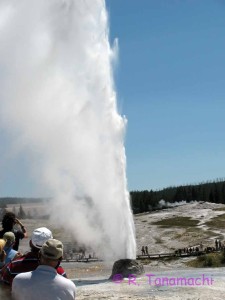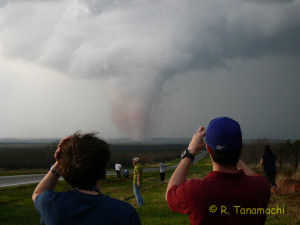Much has been written over the last week about different storm chaser types. Of course, there are as many reasons for storm chasing as there are storm chasers, so trying to categorize them is tricky business. Distinctions like “amateur” and “professional” – often cited by the media in their coverage – don’t make much sense and can vary daily. I wanted to offer up a metaphor that I find useful when I try to explain the myriad reasons for chasing to non-chasers.

National parks are public, and open to all (as long as you pay the entrance fee!). Storm chasing occurs at the intersections of two inherently public things: weather and roadways. Therefore, anyone who holds a valid driver’s license is potentially a storm chaser. Some people go out with no intention of storm chasing, but are drawn into the hobby in the moment. To me, proposing to legislate or license storm chasing is about as nonsensical as restricting Yellowstone to only geographers and biologists.

National parks can be dangerous. Yellowstone in particular has a diverse collection of hazards – scalding hot springs, bears, bison, steep cliffs, avalanches, rapids, etc. (Incidentally, the book Death in Yellowstone offers a fascinating, if morbid, glimpse at those who have perished within the park’s borders, and how they met their ends.) A thunderstorm, too, can imperil the lives of whose who venture within its domain, deserving or not. People can choose whether to educate themselves about the hazards they will encounter in an effort to minimize their risk. As we saw a week ago, however, Mother Nature always gets the last word, and any sense of control that we have over the situation is illusory. Even the most experienced take their lives into their own hands in an encounter with a storm, or a bear. (There’s a reason we call the area beneath the meso “the bear’s cage“!)
It’s not a perfect analog, but it goes a long way towards explaining to non-storm chasers the complexities inherent in trying to categorize storm chasers. Some are there for the storm, some are there for themselves, and others chase for a spectrum of reasons in between. The only thing we have in common is that we are there because the storm is there. Storm chasing is, was, and will continue to be, what we make it.
Robin,
Great and useful metaphors, and post in general! I’ll be sure to credit you when I steal these to better explain chasing to the next person who asks :-).
Thanks; glad to hear you found this useful.
Perfectly said.
I have been tormented with decision of chasing or not, after the deaths of four chasers last week. I am an amateur chaser, that is not paid. I do have experience, but am not a scientist or meteorologist. Your metaphor has helped decide. I will keep chasing(safely, and probably north of Oklahoma) just as geologists and sightseers can look at, and admire a geyser….so can we admire severe weather…..Chase safely!
Jerry – Glad to hear this post was helpful to you. I encourage you to continue to seek out experienced chasers and spotters for guidance. Stay safe out there!
Very thought-provoking post… a few comments …
You make it sound as if everyone is free to do what they please in a National Park, yet there are backcountry permits required in many areas (to limit numbers and track people for safety), and paid guided tour groups are regulated. There are often areas that are restricted access for professional study, and areas closed seasonally for safety reasons. Although its much more difficult to close an area of a moving storm to the public, I could imagine the police blocking a road to prevent people from entering the bear’s cage. In fact I saw this happening in Moore in a media chaser’s video — he drove past the police car, through a non-functioning signal, and then had to quickly back up because he then realized he was getting too close. I don’t like the claim that many chasers seem to make that they should have extra access, ability to violate traffic laws (speeding, passing, traffic signals) because they are “saving lives”. Truth is, especially in a high-population area there are many eyes on the storm and in my opinion there is no need for any individual to be within, say, a quarter-mile of a vortex. Collecting data for sponsored research should have some access, and, my observiation is that the drivers involved in that are generally experienced and law-abiding drivers , but given what happened with Tim Samaras and crew, I wonder if the community and project sponsors will get gunshy about any project that places people with in-situ instruments near and ahead of a meso (e.g. sticknets, turtles or mobile probes)
Finally, The National Parks are not without their regulatory problems as well – they have their own “yahoos” (e.g, people who can endanger others by feeding wildlife), car wrecks from visitors watching the scenery or wildlife instead of the road, and overcrowding/heavy traffic issues during the peak season. The latter has cause them to close certain roads and provide shuttle buses in the most congested areas.
Hi Keith – I never claimed there weren’t any yahoos in national parks – Trust me, we’ve dealt with a few of them! For every person who goes through bear training, there will be others who treat the park like Disney world and try to pet / feed / ride the bears. My understanding is that the back country permitting system is (among other things) meant to deter squabbling over limited numbers of campsites, and since there’s no equivalent to camping under a supercell, that’s one place where the analogy doesn’t work. Like I said, it’s not perfect in every detail; I provide this idea as a relatively simple framework for how to think about other chasers sharing the supercell with you.
Really well stated and well written. I just have a couple of comments.
The geyser, with its scalding hot water and steam, will not change position and overwhelm you. So, that extra added component that adds or demands knowledge of storm structure and evolution is critical to have for those who chase, whether meteorologists, trained scientists in other disciplines or not.
Second, regarding Keith’s comment above, with which I basically agree, I do need to point something out about troopers/highway patrol/police closing roads. Unless they do this under advisement of a meteorologist monitoring the storm in some way, this can (and almost has) lead to catastrophe. In the case of the Rozel, KS tornado of 18 May 2013, police closed an east bound road because they could obviously see a tornado northeast of Rozel. The thing is that tornado was clearly moving northeast. The police created a traffic jam complained about by emergency managers. Then, people approaching that intersection had to turn south or north. The police were unaware that the remnant of the first tornado was essentially on the road further north. They essentially forced people to drive into the path of a tornado. Closing interstates (without detailed knowledge of what is going on around the obvious tornado) obviously can also lead to catastrophes.
You won’t hear any argument from me on this one. While a moving national park analogy works for a lot of things, LEO understanding of severe weather hazards is, unfortunately, not Galilean invariant.
An interesting analogy … thoughtful and very well written, as usual. Any analogy has issues, of course, but the obvious difference, upon which you elaborate, is that we never know where the “park” is going to be, and the sights and sounds mostly vanish, leaving no trace of ever having been there (apart from damage swaths). I find this analogy quite stimulating in explaining what we do and why. The main point is that there is an aspect of nature on display, which attracts people that have a broad range of motives and sense of responsibility. People draw what they wish from having such experiences.
Stumbling upon this years after it was written, via link from a more recent blog post written by Dan Robinson. I really appreciate the metaphor. While one could argue certain aspects of the analogy as it relates to some of the recent controversy over chasers, driving behavior, law enforcement issues, over-crowded roads, etc. as some commenters here have, I definitely intend to borrow the metaphor (with proper attribution of course!) when explaining to people why I chase, why it is so appealing, and why I keep coming back after 20 years.